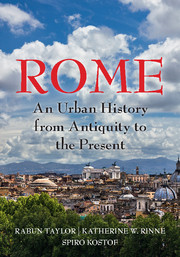Book contents
- Frontmatter
- Dedication
- Epigraph
- Contents
- List of Illustrations
- Acknowledgments
- Map
- INTRODUCTION
- 1 A BEND IN THE RIVER
- 2 A STORYBOOK BEGINNING
- 3 IDEOLOGICAL CROSSFIRE
- 4 BIG MEN ON THE CAMPUS
- 5 RES PUBLICA RESTITUTA
- 6 MEMORIALS IN MOTION: SPECTACLE IN THE CITY
- 7 THE CONCRETE STYLE
- 8 REMAKING ROME'S PUBLIC CORE: I
- 9 REMAKING ROME'S PUBLIC CORE: II
- 10 CRISIS AND CONTINUITY
- 11 RUS IN URBE: A GARDEN CITY
- 12 ADMINISTRATION, INFRASTRUCTURE, AND DISPOSAL OF THE DEAD
- 13 MAPPING, ZONING, AND SEQUESTRATION
- 14 TETRARCHIC AND CONSTANTINIAN ROME
- 15 TROPHIES AND TITULI: CHRISTIAN INFRASTRUCTURE BEFORE CONSTANTINE
- 16 WALLS MAKE CHRISTIANS: FROM FOURTH TO FIFTH CENTURY
- 17 A TALE OF TWO ROMES
- 18 THE ROME OF GOTHS AND BYZANTINES
- 19 CHRISTIAN FOUNDATIONS
- 20 FROM DOMUS LATERANI TO ROMANUM PALATIUM
- 21 THE LEONINE CITY: ST. PETER'S AND THE BORGO
- 22 VIA PAPALIS, THE CHRISTIAN DECUMANUS
- 23 THE URBAN THEATERS OF IMPERIUM AND SPQR
- 24 HOUSING DAILY LIFE
- 25 CHAOS IN THE FORTIFIED CITY
- 26 THE TIBER RIVER
- 27 HUMANIST ROME, ABSOLUTIST ROME (1420–1527)
- 28 PLANNING COUNTER REFORMATION ROME
- 29 PROCESSIONS AND POPULATIONS
- 30 MAGNIFICENT PALACES AND RHETORICAL CHURCHES
- 31 NEOCLASSICAL ROME
- 32 PICTURING ROME
- 33 REVOLUTION AND RISORGIMENTO
- 34 ITALIAN NATIONALISM AND ROMANITÀ
- 35 A CITY TURNED INSIDE OUT
- Glossary of Persons, Places, and Terms
- Works Cited
- Index
10 - CRISIS AND CONTINUITY
Published online by Cambridge University Press: 05 July 2016
- Frontmatter
- Dedication
- Epigraph
- Contents
- List of Illustrations
- Acknowledgments
- Map
- INTRODUCTION
- 1 A BEND IN THE RIVER
- 2 A STORYBOOK BEGINNING
- 3 IDEOLOGICAL CROSSFIRE
- 4 BIG MEN ON THE CAMPUS
- 5 RES PUBLICA RESTITUTA
- 6 MEMORIALS IN MOTION: SPECTACLE IN THE CITY
- 7 THE CONCRETE STYLE
- 8 REMAKING ROME'S PUBLIC CORE: I
- 9 REMAKING ROME'S PUBLIC CORE: II
- 10 CRISIS AND CONTINUITY
- 11 RUS IN URBE: A GARDEN CITY
- 12 ADMINISTRATION, INFRASTRUCTURE, AND DISPOSAL OF THE DEAD
- 13 MAPPING, ZONING, AND SEQUESTRATION
- 14 TETRARCHIC AND CONSTANTINIAN ROME
- 15 TROPHIES AND TITULI: CHRISTIAN INFRASTRUCTURE BEFORE CONSTANTINE
- 16 WALLS MAKE CHRISTIANS: FROM FOURTH TO FIFTH CENTURY
- 17 A TALE OF TWO ROMES
- 18 THE ROME OF GOTHS AND BYZANTINES
- 19 CHRISTIAN FOUNDATIONS
- 20 FROM DOMUS LATERANI TO ROMANUM PALATIUM
- 21 THE LEONINE CITY: ST. PETER'S AND THE BORGO
- 22 VIA PAPALIS, THE CHRISTIAN DECUMANUS
- 23 THE URBAN THEATERS OF IMPERIUM AND SPQR
- 24 HOUSING DAILY LIFE
- 25 CHAOS IN THE FORTIFIED CITY
- 26 THE TIBER RIVER
- 27 HUMANIST ROME, ABSOLUTIST ROME (1420–1527)
- 28 PLANNING COUNTER REFORMATION ROME
- 29 PROCESSIONS AND POPULATIONS
- 30 MAGNIFICENT PALACES AND RHETORICAL CHURCHES
- 31 NEOCLASSICAL ROME
- 32 PICTURING ROME
- 33 REVOLUTION AND RISORGIMENTO
- 34 ITALIAN NATIONALISM AND ROMANITÀ
- 35 A CITY TURNED INSIDE OUT
- Glossary of Persons, Places, and Terms
- Works Cited
- Index
Summary
THE QUIET REIGN OF FAUSTINA'S HUSBAND, ANTONINUS PIUS (138–161), HAS been characterized, rightly or wrongly, as an Elysium of stability and prosperity. That of his adopted successor, Marcus Aurelius (161–180), troubled by pandemics, barbarian invasions, and economic difficulties, epitomizes crisis and reaction. Yet at Rome, evidence of this contrast – whether drawn from historical accounts, cemetery data, building projects, or inscriptions – is mostly invisible. Under these two Antonine rulers the city suffered few discernible systemic difficulties. Pius built sparingly – his most famous works were temples, one for the deified Hadrian in the Campus Martius and one for his deified wife, and ultimately for himself, on the Forum. Marcus and his son and coemperor Commodus (177–192) built even less; but inscriptions throughout their successive reigns signal a fairly healthy and robust city life. That is not to say that decline did not occur; we simply cannot detect it. And while it is true that Rome was propped up economically with subsidies and other artificial inducements, it would be naïve to presume that a notorious plague that ravaged the empire between about 165 and 180 took no toll here. Nevertheless, the great age of urban expansion was over. Rome would again witness bursts of urban creativity and renewal, but those episodes gradually devolved into a zero-sum game of certain finite physical resources such as water, marble, and granite. By the early fourth century few monumental structures were built without ransacking others.
Some imperial marble quarries were closed during the plague, but the marble yards at Portus and Rome may have been adequately stocked to cushion the blow. Indices of a falloff in building activity we have in abundance: fewer new buildings, fewer dated brick stamps, no new aqueducts for a century after 109. A Trajanic river wharf at the Emporium specializing in building stone seems to have been derelict by the century's end (see Fig. 89). None of these things remotely signals urban decline; Rome had simply reached a saturation point of development. Not coincidentally, for eight decades after 110 there were no citywide fires to whet an emperor's appetite for intervention. It was an appropriate time to take stock. Around 175 or shortly thereafter, Marcus and Commodus expanded the old customs boundary established a century earlier to align it more with Rome's built-up area (see Chapter 13).
- Type
- Chapter
- Information
- RomeAn Urban History from Antiquity to the Present, pp. 93 - 102Publisher: Cambridge University PressPrint publication year: 2016



